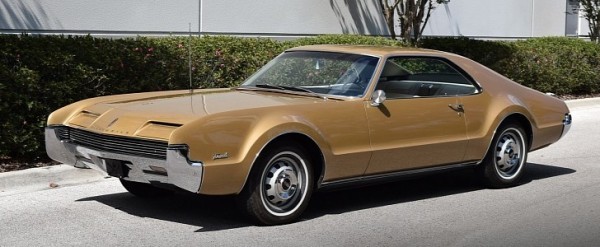55 Years Ago: the Oldsmobile Toronado Was the Opposite of a Pony Car
The 1966 Oldsmobile Toronado should be included in the most exclusive reference gallery of American design. It features a clean overall appearance with superbly integrated details on the outside, hood-based pop-up headlamps, a fluid connection for the body's volumes, as well as monumental size and proportions. The first generation of the Oldsmobile Toronado dynasty remains unparalleled in terms of distinction, advanced styling, and finely engineered tech.
This was one of the few top-class American coupes designed during the sixties that lacked tailfins. Actually, it was designed in a completely different way than anything before it. The rear end configuration suggests that the long and thin red lights could turn incendescent and act like reactive thrusters.
The front grille is thin and almost as wide as the car itself. It makes you think it is an air intake properly sized for feeding the symbolic rear “thrusters.” It's a special kind of visual magic, signed by David North and overseen by Bill Mitchell.
By the way, 1966 is also the debut year for Star Trek, the original series showing the starship Enterprise 1701-A (Constitution Class starship). Decades later, the Star Trek: First Contact spin-off movie shows us the Enterprise 1701-E, an awe-inspiring starship belonging to the “Sovereign Class,” impressive both by dimensions and by the built-in technology. Coming back to our stuff, the 1966 Oldsmobile Toronado should be considered the “Sovereign Class” vessel among contemporary American coupes.
The hood of the 1966 Toronado hides the so-called Unitized Power Package (UPP), definitely a daring vision from an engineering standpoint. Soon, it was also used on the Caddy Eldorado and the Buick Riviera. The 7.0-liter “Super Rocket” V8 aspirated engine is mated with a heavy-duty Turbo-Hydramatic 400 three-speed automatic transmission. This assembly's dimensions had to be kept quite compact, since the project specifications included the criteria of a front-wheel-drive system.
Even by today’s standards, 385 hp of maximum power and up to 475 lb-ft (644 Nm) of torque applied to the front wheels seem to be overwhelming figures. Yet, the 1966 Toronado drove well and offered a remarkably safe road-holding. Wanna see one of these in “attack mode” doing the Pike’s Peak climb track? In fact, you would have no excuse for missing such a spectacle.
The front grille is thin and almost as wide as the car itself. It makes you think it is an air intake properly sized for feeding the symbolic rear “thrusters.” It's a special kind of visual magic, signed by David North and overseen by Bill Mitchell.
By the way, 1966 is also the debut year for Star Trek, the original series showing the starship Enterprise 1701-A (Constitution Class starship). Decades later, the Star Trek: First Contact spin-off movie shows us the Enterprise 1701-E, an awe-inspiring starship belonging to the “Sovereign Class,” impressive both by dimensions and by the built-in technology. Coming back to our stuff, the 1966 Oldsmobile Toronado should be considered the “Sovereign Class” vessel among contemporary American coupes.
The hood of the 1966 Toronado hides the so-called Unitized Power Package (UPP), definitely a daring vision from an engineering standpoint. Soon, it was also used on the Caddy Eldorado and the Buick Riviera. The 7.0-liter “Super Rocket” V8 aspirated engine is mated with a heavy-duty Turbo-Hydramatic 400 three-speed automatic transmission. This assembly's dimensions had to be kept quite compact, since the project specifications included the criteria of a front-wheel-drive system.
Even by today’s standards, 385 hp of maximum power and up to 475 lb-ft (644 Nm) of torque applied to the front wheels seem to be overwhelming figures. Yet, the 1966 Toronado drove well and offered a remarkably safe road-holding. Wanna see one of these in “attack mode” doing the Pike’s Peak climb track? In fact, you would have no excuse for missing such a spectacle.















No comments:
Post a Comment